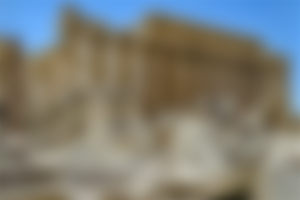The Seven Wonders of the World - Old & New Lists
Obviously, making lists is inherently human. We find lists everywhere about everything. Combine that with the human obsession with number seven, the first list coming to mind is that over the seven wonders of the world.
"Sostratus, the son of Dexiphanes, the Cnidian, dedicated this to the Saviour Gods, on behalf of those who sail the seas."
(Dedicatory inscription of the Lighthouse of Alexandria)
The oldest still preserved list of the Seven Wonders of the World was compiled by Antipater of Sidon, who was living in Alexandria in the middle of the second century B.C. It is quite clear though, that in his poem about them, he takes for granted that the reader is already familiar with such a list. So it can be a well-founded guess, that lists were compiled much earlier.
The historian Herodotus and the scholar Callimachus of Cyrene (ca 305–240 B.C.) made lists that have not been preserved, but are partly known due to references. There is no reason not to think there were others.
A list in a text named "De septem orbis spectaculis", previously incorrectly attributed to Philon (2nd century B.C), a Byzantine mathematician, can be as new as from the 6th century A.D. It is often quoted though.
Circulating lists are not all identical.
The most common list from Antiquity is this:
The Great Pyramid of Cheops
The Hanging Gardens of Babylon
The Statue of Zeus at Olympia
The Temple of Artemis (Diana) at Ephesus
The Tomb of King Mausolus at Halicarnassus
The Colossus of Rhodes on the Isle of Rhodes
The Lighthouse on the Isle of Pharos
Another list, which is probably older. One can assume that it was compiled before the Lighthouse of Alexandria existed. (The building was authorised by Ptolemy in 290 B.C.)
The Walls of Babylon
The Statue of Zeus at Olympia
The Hanging Gardens of Babylon
The Colossus of Rhodes
The Pyramids at Memphis
The Tomb of King Mausolus
The Temple of Artemis at Ephesus
Occasionally other objects were included, like the Ishtar Gate, but the two lists above are the most well-known today.

Other objects turned up during Roman times. The poet, Martialis, for instance, uses the latter list above, but changed 2 and 4 to the Apollo Altar at Delus, and The Colosseum of Rome.
During the 16th century, another list was compiled by English and French writers.
The Colosseum of Rome
The Catacombs of Alexandria
The Great Wall of China
Stonehenge
The Leaning Tower of Pisa
The Porcelain Tower of Nanking
The Haga Sophia, Constantinople
Some other objects occasionally discussed at that time were: The Saladin Citadel of Cairo; Taj Mahal; The Cathedral Church of the Holy and Undivided Trinity of Ely; and The Abbey of Cluny.
The attraction of making a list of seven wonders has inspired many attempts to compile analogous lists - sometimes covering slightly different objects, like nature or engineering. They might be representative of a certain organisation or even a certain individual.
In her book, The Golden Book of Facts and Figures (1962), Bertha Morris Parker lists what she thinks are the seven wonders of the modern world.
1. Empire State Building
2. Jodrell Bank Telescope (A Radio Telescope in England.)
3. Golden Gate Bridge
4. Panama Canal
5. Sputnik 1 (The first artificial satellite in space.)
6. Hoover Dam (Between Nevada and Arizona.)
7. Nautilus (The first atomic power driven submarine.)
This is a list by American Society of Civil Engineers.
1. Channel Tunnel, Strait of Dover, between England & France
2. CN Tower, Toronto, Ontario, Canada
3. Empire State Building, New York, New York, USA
4. Golden Gate Bridge, San Francisco, California, USA
5. Itaipu Dam, Paraná River, South America
6. Delta Works, Netherlands, Europe
7. Panama Canal, Isthmus of Panama, Central America
In 1954, Willy Ley tried to predict 7 future wonders of the world. The list was found in his book "Engineers' Dreams". How correct were his predictions?
1. The Channel Tunnel. In 1802 came the first proposed plan for a tunnel under the English Channel, between England and France. For a long time financial and military concerns held the project back. In 1994 the tunnel was finished, and ready to use.
2. The Aerogenerator. A wind-powered generator was first completed in 1925. For a short time in 1941 , it was really used, but a large scale use of this sort of energy is still more wishful thinking than reality.
3. The Tamed Volcano. In 1930 it was found that a hot spring in Tuscany could be tapped and used as a source of energy. Later, a theory was presented, that the deeper one digs, anywhere, the hotter it gets. At least in theory this would offer a huge source of energy. This principle is presently utilized in some places of the world.
4. Valley of the Jordan. Irrigation and electric power for Palestine - a dam, a canal, a reservoir, and a power plant.
5. Africa's Central Lake. Herman Sörgel made a plan to form two freshwater lakes in central Africa. This was 1935.
6. Atlantropa. The same Herman Sörgel wanted to unite Europe and Africa by reclaiming land beneath the Mediterranean Sea. That was 1928. There was much support for the idea at the time.
7. Solar Energy. The first use of solar power was 1615 - to power toys.
New 7 Wonders
In 2007 a Swiss organisation, new7wonders, compiled a new list of Seven Wonders of the world by popular vote. They had nominated 21 candidates to choose from.
These were nominated wonders at New7Wonders:
http://www.new7wonders.com/index.php
1. The Acropolis of Athens (450-330 B.C.).
2. Alhambra (12th century), Granada, Spain.
3. Angkor (12th century), Cambodia.
4. The Pyramid at Chichén Itzá (before 800 A.D.), Yucatan Peninsula, Mexico.
5. Christ Redeemer (1931), Rio de Janeiro, Brazil.
6. The Roman Colosseum (70-82 A.D.), Rome, Italy.
7. Statues of Easter Island (10th-16th Century), Easter Island, Chile.
8. The Eiffel Tower (1887-89), Paris, France.
9. The Great Wall of China (220 B.C and 1368-1644 A.D.).
10. The Hagia Sophia (532-537 A.D.), Istanbul, Turkey.
11. Kiyomizu Temple (749-1855), Kyoto, Japan.
12. The Kremlin and Red Square (1156-1850), Moscow, Russia.
13. Machu Picchu (1460-1470), Peru.
14. Neuschwanstein Castle (1869-1884), Schwangau, Germany.
15. Petra (9 B.C.-40 A.D.), Jordan.
16. The Pyramids of Giza (2600-2500 B.C), Egypt.
17. The Statue of Liberty (1886), New York City, U.S.A.
18. Stonehenge (3000 B.C.-1600 B.C.), United Kingdom.
19. Sydney Opera House (1954-73), Sydney, Australia.
20. The Taj Mahal (1630 A.D.), Agra, India.
21. Timbuktu (12th century), Mali.

In my opinion, The Pyramids of Giza, The Great Wall of China, and Angkor in Cambodia are indisputable choices. But on speaking about Giza, don't forget the Sphinx!
A few of the candidates appear to me as sadly misplaced in that otherwise illustrious company. The most striking examples are the Sydney Opera House and the Eiffel Tower. Fascinating buildings they are, but no"wonders". To me it seems like an attempt at "geographical spreading at any cost" rather than a matter of qualification.
On the other hand a lot of worthy candidates are not nominated at all. India, for instance, has much more than The Taj Mahal to offer; Java, in Indonesia, has Borubudur; Myanmar (Burma) has some wonderful Buddhistic architecture; just to mention a few...
Then there is Baalbek. Maybe it is too much a ruin to be qualified, but it is still the most impressing man made construction I have ever encountered... and I have seen a lot!
http://www.sacredsites.com/middle_east/lebanon/baalbek.htm
http://www.bibliotecapleyades.net/esp_baalbek_1.htm
http://www.middleeast.com/baalbeck.htm

The resulting list, however was this:
1. The Great Wall of China.
2. Petra, Jordan.
3. Machu Picchu, Peru.
4. The Pyramid at Chichen Itza, Mexico.
5. The Taj Mahal, Agra, India.
6. Christ Redeemer, Rio de Janeiro, Brazil.
7. The Roman Colosseum, Italy.
The order does not imply any ranking.
The Pyramids of Giza were removed from the poll, and given the title Honorary New7Wonders Candidate, since they are the only wonder remaining from the antiquity's list. Then 7 other wonders were announced. It is unclear why the pyramids were denoted as a "candidate", or why they were not given a place among the seven automatically (based on the same argument, that they are a wonder from antiquity still existing).
There are many reasons to criticise and question The New7Wonders, the organisation, the project, and the list. I will not dwell on that though; many others are doing it anyway - sometimes with much more grave frenzy than a game like this deserves.
Why not making your own list? What is your subjective choice for the Seven Wonders of the World? See it as a writing prompt if you like.
Other articles related to number seven:
What is Special with Number 7?
Copyright © 2007, 2019, 2022 Meleonymica/Mictorrani. All Rights Reserved.
Images:
Giza. Photo: Cezzare/Pixabay. CC0/Public Domain.
Angkor Wat. Photo: sharonang/Pixabay. CC0/Public Domain.
Baalbek, the Jupiter Temple. Photo: djedj/Pixabay. CC0/Public Domain.
(Lead Image/Thumbnail: From Baalbek. Photo: Ronile/Pixabay. CC0/Public Domain.)
My articles on history can be found here.
You find all my writings on Read.Cash, sorted by topic, here.
Also, please join my community History, Myths, Legends & Mysteries (be45).



Honestly all the list you have mentioned are my dream place someday. I don't want to die in this world without seeing those historical places and for me life is wasted if I won't have the chance to see those wonderful places. I want to be in the pyramid of Giza, in the hanging gardens of Babylon, in the colosseum and so many more that I want to fulfill in my lifetime someday.